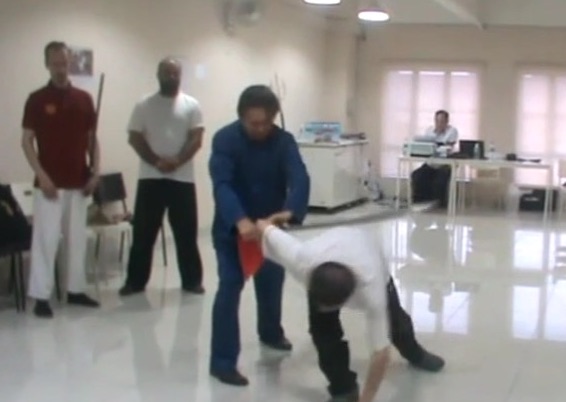THE PHILOSOPHY OF WEAPONS AND HOW TO CAPTURE THEM

Sifu Wong demonstrates how to capture a weapon from an opponent
Question
The philosophy in level 8 of our basic syllabus touches on the “principles of weapon combat”.
Can you please elaborate a bit on which principles you find most important when fighting with weapons and about the basic principles of each of the weapon classes?
Sifu Leonard Lackinger
Answer
In level 8 under “Philosophy” of our Shaolin basic syllabus, the topic is “principles of weapon combat”. Under “Note”, the following factors are listed: safety, certainty and decisiveness, avoiding strength and attacking weakness.
Under “Form”, the Flowing Water Staff is learnt. Under “Application”, students apply the staff against another staff and other weapons. Under “force”, students learn “hit force”, “thrust force” and eye sight training.
In level 8 students learn the Flowing Water Staff, which is one of the four best staff sets in the whole of kungfu, and the staff is a fundamental Shaolin weapon. Students learn the combat application of the staff against another staff and other weapons.
A good way to test “hit force” is to strike a coconut placed on the ground. A good way to train “thrust force” is to hang a tire on the staff and thrust out the staff. A good way to train eyesight is to observe a candle flame at night.
“Safety first” is a paramount principle in weapon training, especially when an opponent is holding a blade weapon. A few principles are important, like “don’t be in the direction of a pointed weapon” and “don’t be in the momentum of a blade-weapon”.
If an opponent is holding a dagger, it is important not to be in the direction of the dagger. When capturing a dagger, be aware of the opponent using a technique known as “dispersing flowers”. This will be learnt at the course.
If an opponent is holding a sabre, it is important not to be in the momentum of the sabre. When capturing a sabre, be aware of the opponent using a technique known as “reverse slash”. This will also be learnt at the course.
One must be certain when capturing a weapon. The exponent cannot take any chance. When hitting an opponent holding a weapon, he must be decisive. He must hit at the head or vital points.
The strength of a pointed weapon, like a dagger, a sword or a spear, is the thrust. The strength of a bladed weapon, like a sabre, a sword, or a Guan Dao is the slash (or a chop). A staff is the mother of weapons. It can apply the thrust and the slash.
The weakness of a weapon is the wrist for a short weapon, and the arms for a long weapon. It is easy to capture a weapon if the exponent knows the strength and the weakness of the weapon. It is impossible if he does not know the techniques.
In Taijiquan the Wudang Sword is leant. Students will learn the combat application of the Wudang Sword. The Chinese sword is like a dainty lady; it should avoid an opponent’s weapon, especially a heavy weapon, otherwise the sword will be broken into pieces.
An excellent pattern to channel energy to the tip of a sword is “Green Dragon Shoots Pearl”.
Agility and wrist work are very important in learning to use a sword.
Traditionally, weapons are classified into 18 types. But different times referred to different types of 18 weapons. There are actually more than 18 weapns.
Weapons may be classified into long and short, and heavy and light. Such classifications overlap. Hence a spear is a long, light weapon. A Guan Dao is a long, heavy weapon. A pair of butterfly knives is a short, light weapon. A pair of Copper Legumes (or round hammers) is a short, heavy weapon.
Weapons can also be pointed or bladed. A sabre is bladed, and is used for cutting. A spear is pointed, and is used for piercing.
A pointed weapon, like a wavy-head lance or a big trident, is used for piercing or thrusting. A bladed weapon, like a big knife or a pair of tiger-hooks, is used for cutting.
There is a kungfu saying that “yi cun chang, yi cun qiang; yi cun duan, yi cun miao”, which means “an inch longer, an inch stronger; an inch shorter, an inch more marvellous”. A long weapon has the advantage of length, but a short weapon can be used marvellously. A spear is long, and keeps an opponent at bay. Butterfly knives are short, and can be very tricky.
The questions and answers are reproduced from the thread 10 Questions on "Becoming a Shaolin Wahnam Kungfu Practitioner" in the Shaolin Wahnam Discussion Forum.
LINKS
